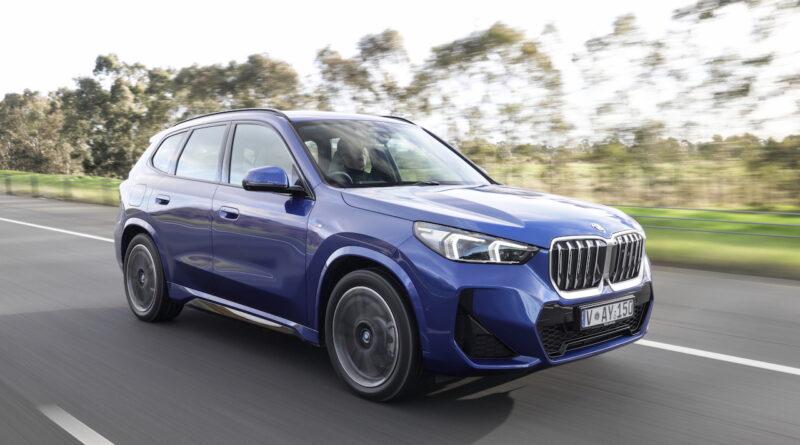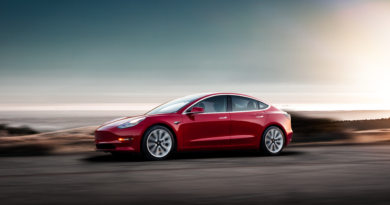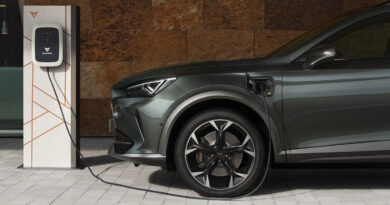2023 BMW iX1 review: How does this premium electric SUV stack up against Tesla, Mercedes-Benz and Volvo in Australia?
EV Central’s BMW iX1 review: It’s drifting into ancient history now but BMW was a real battery electric vehicle trendsetter when it launched the i3 back in 2013.
Assembled in carbon-fibre and recycled materials and with its reverse-opening rear doors and rear-wheel drive it was an idiosyncratic statement of groundbreaking intent.
An intent the German luxury brand has veered away from in more recent times, seeking a less ambitious path for it advancement into EVs.
A spin-off from the petrol-powered X1, the newly arrived iX1 compact SUV is undoubtedly proof of that. The most affordable BMW BEV since the i3 is its opposite when it comes to risk taking.
That doesn’t make it a bad BEV, in fact unlike the i3 it might be very successful.
READ MORE: The electric year ahead: Every EV coming to Australia in 2023
READ MORE: The five best family EVs under $100K: From Tesla and Hyundai to Kia and Mercedes-Benz
READ MORE: Can the Model Y outsell the HiLux and Ranger?
Price and features
BMW hasn’t hesitated to come out confidently with the pricing of the iX1, setting it higher than the starting point of any of its luxury compact SUV opposition at $84,900 plus on-road costs.
That opposition includes the Lexus UX 300e, Mercedes-Benz EQA, Volvo XC40 and C40 and two of three models in the all-conquering Tesla Model Y line-up.
The iX1’s pricing means it just scrapes in under the luxury car tax threshold, but you can forget about state-based rebates or the federal FBT exemption.
There are two identically-priced iX1 models differentiated by cosmetics; the xLine and the M Sport. The latter is expected to account for 80 per cent of sales and is the one we are driving here.
Equipment the two vehicles share includes dual-zone climate control operated via a heat pump, remote access and keyless start, powered and heated front seats with memory for the driver and a power tailgate.
More imposingly, they also get a 10.7-inch touchscreen and a 10.25-inch instrument display sitting behind a single piece of curved glass on the dashboard. Infotainment is run by BMW’s new Operating System 8 and heralds a wholesale reduction in buttons and dials.
Wireless Apple Carplay and Android Auto, wireless smartphone charging, embedded satellite navigation and DAB+ digital radio are all standard. The iX1 comes with an unbranded six-speaker system.
M Sport gets its own 19-inch double-spoke alloy wheel design, M roof rails, Alcantara/Sensatec (artificial leather) upholstery an M Sport steering wheel and a heap more less significant dress-up bits.
The xLine comes with V-spoke alloy wheels, more chrome exterior trims and BMW rather than M badging. Inside the trim is in Sensatec alone.
A $4700 option pack includes metallic paint, a panoramic sunroof, a Harman Kardon sound system and active seats with a massage function. These items were standard when the iX1 was first announced in Australia last November, but that changed in March at the same time as the price was bumped up $2000.
iX1 tyres are not run-flats and there is no spare, only a repair kit and tyre pressure monitoring.
The iX1 is protected by a five-year/unlimited kilometre warranty and the li-ion battery pack for eight years/160,000km.
Servicing is conditions-based, which means when the car reckons its needs it. A basic service package will set you back $1263 over four years and $1800 over six years. The more comprehensive Plus package is $4784 and $5784 over the same periods.

Interior space
If by some chance you’ve had the chance to look in the standard third generation BMW X1 before casting an eye over the iX1 then you are going to notice a lot of similarities.
That’s because they are the same five-seat five-door compact SUV with the same measurements in almost all ways.
So what you get is a very well appointed interior using high quality materials meticulously bolted together.
There are generous helpings of artificial leather on the seats, doors and dashboard. Only the steering wheel has real leather.
More practically it also has reach and rake adjustment that helps the driver get comfortable.
Space in the rear seat is adequate for legroom and good for headroom. Because it rides on a modular platform shared with ICE vehicles there is a transmission tunnel that compromises the middle position.
The iX1’s boot measures up at 490 litres, which expands to 1495 litres with the 40:20:40 rear seat folded. Those are decent numbers but they are down on 540L/1600L X1 because of the battery pack and electric motor underneath. There is no frunk up-front.
Our test car came with the $4700 options pack and we can confirm the front seats are comfortable and the stereo pumps.
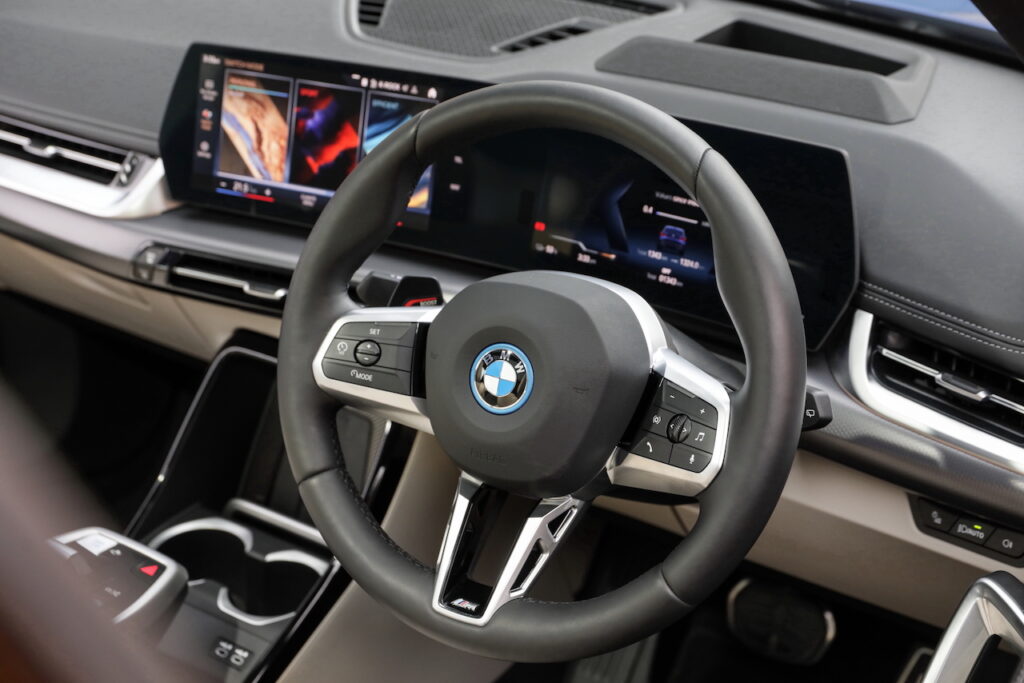
Performance and Efficiency
Here’s where the BMW iX1 really kicks sand in the face of its petrol X1 siblings.
It is powered by an electrically excited synchronous e-motor on each axle that combine to produce 230kW and 494Nm.
There’s a bit of novelty with all this as the last 30kW is made available in the M Sport by tapping a lever behind the steering wheel – you even get a 10 second countdown on the instrument cluster.
The paddle is missing on the xLine. BMW isn’t sure how, but we’re assured it also gets 230kW.
The powertrain is completed by a two-stage single speed transmission and BMW claims a 0-100km/h time as good as 5.6 seconds and an electronically limited top speed of 180km/h.
Charging
BMW claims a power consumption average of 18.3kWh/100km for the BMW iX1 and a range out of the 67kWh lithium-ion battery pack of 400km. Both are on the local ADR cycle.
Add in a DC fast-charge rate that tops out at a claimed 130kW and you can see the iX1 is not cutting edge for range or recharging.
It’s a fundamental disappointment in a car this price when a $30,000 cheaper BYD Atto 3 can go further. Or the $6500 cheaper Tesla Model Y Long Range much further and charge much faster.
The iX1 has a better story to tell with its max 22kW AC charging rate. While you need three-phase power at home to exploit it, BMW points out it will be helpful at public AC chargers as well.
At its most efficient, BMW says the iX1 can recharge its battery from 10-80 per cent in 29 minutes.
At 11kW AC – which also requires three phase power – BMW says the iX1 will recharge from 0-100 per cent in in 6.5 hours. Using a standard home 230V outlet, trickle charging would take about 30 hours.
The iX1 also adds charge via recuperation while driving. There is a single pedal mode for max brake effect and four driver-selectable modes including adaptive. The latter regens at a rate the car’s brain thinks suitable at the right time. The practical effect is a variable braking response that can be disconcerting.
Both Mode 2 and Mode 3 charging cables are included standard with the iX1, along with a three year Chargefox network subscription.
The iX1 has no Vehicle to Load or vehicle to Grid capability.

Ride and handling
If you’re less concerned about the powertrain’s range and charging capabilities and more focussed on how it helps the iX1’s driving behaviour then right here it claims a lot of ground back.
This is a fast, cohesive and enjoyably resolved vehicle to drive.
At 2010kg its more than 400kg than the heaviest X1, but its well-tuned adaptive dampers help ensure its neither too blowsy or terse.
It has that BMW feeling of alertness that a sharp chassis tune and strong powertrain deliver. With the battery pack slung low between the axles it can be hustled along with some enthusiasm and without much body roll.
Only a less than convincing electric-assist steering tune disappoints.
Even with that weight there is no shortage of tip-in or mid-range acceleration and there’s no doubt the boost paddle works, even if it is a gimmick.
Interacting with the infotainment system of the iX1 is the main driving distraction and frustration. With so many buttons deleted – including the iDrive controller -so many functions seem more complex now.
Even the air-conditioning system needs to be operated through the screen (or via voice control). Adjusting the regenerative braking requires six steps!
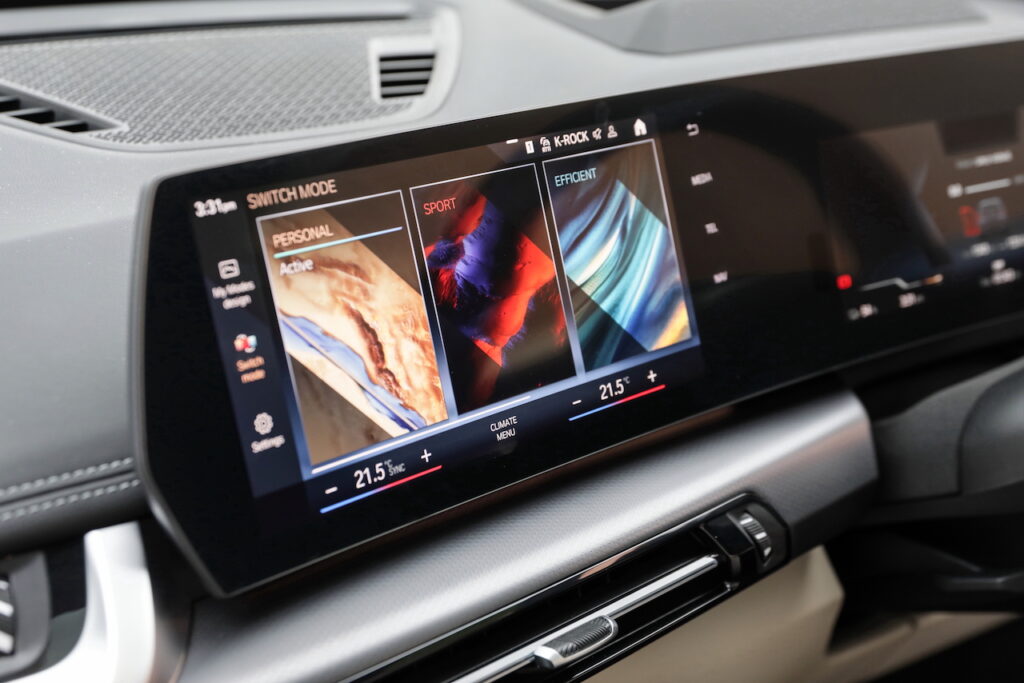
Talking point
Establishing the mood via the mode is a a big thing with the new BMW iX1. The more aggressive you make the driving mode the more artificial whirring (composed by Academy Award winner Hans Zimmer) is piped into the cabin.
There are also Expressive, Relax and Digital Art modes that are more about affecting the iX1’s ambience than the driving.
Safety
Standard BMW iX1 safety equipment includes front, front-side and curtain airbags, as well as a centre-front airbag to prevent head knocks.
Autonomous emergency braking comes with evasion assist and pedestrian and cyclist detection. Active cruise control with stop and go is also part of the package.
Cameras and sensors allow the iX1 to brake for crossing traffic front and rear, actively steer to stay centred in its lane, warn and counter-steer when veering from its lane and adjust its speed to keep it legal.
The iX1 also includes a head up display, multiple camera angles including surround view, a drive recorder and a suite of parking and reversing aids including the ability to reverse autonomously for 50 metres. For going forwards in the dark, adaptive LED headlights come with high-beam assist.
A three-year subscription to BMW ConnectedDrive includes emergency call and real time traffic information.
There are three child seat top tether mounts on the rear seats and ISOFIX mounts on the outboard rear seats.
While the X1 comes with a five-star ANCAP rating, the iX1 is yet to be rated.

Verdict
Score: 7.0/10
So we’ve established the BMW iX1 is no BMW i3.
Instead, it is a decent compact luxury SUV in the way it looks, the way it drives and the way it is equipped.
However, it is less convincing as an EV in how far it can go between recharges and the maximum DC fast-charge rate – even if it beats anything the i3 ever achieved. That’s progress folks.
On top of that is the price you pay for it.
This is a BMW BEV for the fans. It will sit nicely in the garage beside an X5 and an M4. A premium electric SUV with more range and faster recharging at a cheaper price will appeal to most EV buyers more. It’s called the Tesla Model Y.
BMW iX1 M Sport
Price: $84,900 plus on-road costs
Basics: EV, 5 seats, 5 doors, compact hatchback, AWD
Range: 400km (ADR)
Battery capacity: 67kWh
Battery warranty: 8 years/160,000km
Energy consumption: 18.3kWh/100km (ADR)
Motors: One on each axle, combined maximum output 230kW/494Nm
AC charging: 22kW, Type 2 plug
DC charging: 130kW (approx), CCS combo plug
0-100km/h: 5.6 seconds (claimed)

